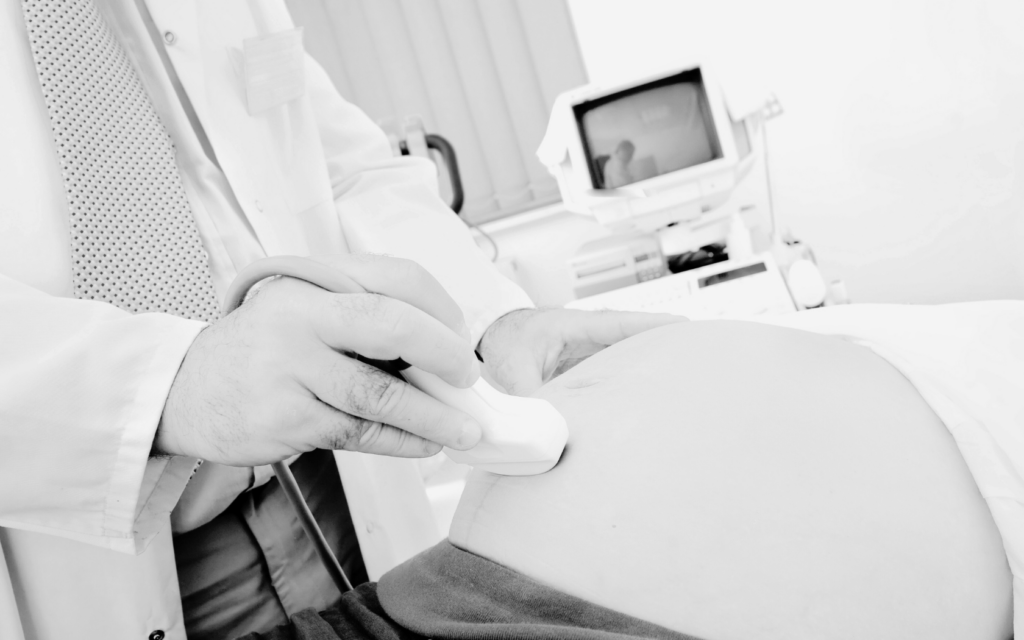No pain is greater than that of losing a child. Intrauterine fetal demise (IUFD), the heartbreaking loss of a baby in the womb, leaves parents facing deep sorrow and unanswered questions.
In this article, we’ll aim to shed light on the causes, risk factors, and emotional impact of IUFD. We’ll also discuss how some cases of IUFD result from medical negligence. If you suspect a doctor’s mistake cost your child their life, contact our legal team. We may be able to help you file a medical malpractice lawsuit. Through a lawsuit, you can hold your providers responsible for what happened.

What is Intrauterine Fetal Demise?
Intrauterine fetal demise (UIFD) is when a fetus passes away in the womb after 20 weeks gestation. It’s also known as stillbirth.
Stillbirth isn’t the same as a miscarriage. A miscarriage is when a fetus dies before 20 weeks gestation. According to the American College of Obstetricians and Gynecologists, stillbirth happens in about 1 in 160 births.
There are three different types of IUFD:
- Early: Between 20-24 weeks gestation
- Late: Between 28 and 36 weeks of gestation
- Term: After 37 weeks of gestation
IUFD Pregnancy Risk Factors
It’s not always possible to prevent stillbirth. But you may be able to reduce the likelihood of it. You can do so by making sure you don’t take any harmful substances while pregnant, and by seeing your doctor often to get proper medical care.
Certain factors can heighten the risk of stillbirth. Doctors are trained to recognize these factors and manage as much as possible to prevent IUFD.
Possible IUFD pregnancy risk factors include:
- Having uncontrolled maternal health conditions, like hypertension, diabetes, or obesity
- Smoking or using alcohol while pregnant
- Developing pregnancy-related conditions like placental abruption (separation of the placenta from the uterus)
- Having a maternal infection like cytomegalovirus
- Being over 35 years old while pregnant
- Teenage pregnancy
- Having twins or multiples
- Having a history of pregnancy loss or preterm birth
Signs of Intrauterine Fetal Demise
Has your doctor ever told you to “count kicks”? There’s a very good reason why you should pay attention to your little one’s karate moves in the womb. Little to no movement can be a sign of IUFD.
Another sign is not hearing the baby’s heartbeat. During checkups, doctors use a special tool to listen to the baby’s heart. If they cannot find a heartbeat, it might mean the baby has died.
When a baby passes away in the womb, a woman may experience signs of sudden pregnancy loss. These include:
- Cramps or pain in the abdomen
- Nausea
- Breast tenderness
- Vaginal bleeding
- Infection or high fever

What Causes IUFD?
The cause of IUFD isn’t always obvious. Sometimes doctors can’t pinpoint the cause at all. But some common causes of intrauterine fetal demise include:
Maternal Health Issues
- Hypertension and Preeclampsia: High blood pressure during pregnancy can affect blood flow to the placenta.
- Diabetes: Poorly controlled diabetes can lead to complications.
- Thrombophilia: Blood clotting disorders can affect the placenta.
- Autoimmune Diseases: Conditions like lupus can impact pregnancy.
Placental Problems
- Placental Abruption: The placenta separates from the uterine wall too early.
- Placental Insufficiency: The placenta doesn’t provide enough oxygen and nutrients to the fetus.
- Placenta Previa: The placenta covers the cervix, causing complications.
Fetal Conditions
- Genetic and Chromosomal Abnormalities: This includes conditions like Down syndrome.
- Congenital Malformations: These are birth defects that affect fetal development.
- Infections: Infections such as cytomegalovirus, syphilis, and toxoplasmosis can harm the fetus.
Maternal Infections
- Maternal Infections: Infections like listeriosis, rubella, and group B streptococcus are very dangerous for a fetus.
- Urinary Tract Infections (UTIs): UTIs can lead to complications if untreated.
Umbilical Cord Issues
- Cord Accidents: Prolapse, knotting, or compression of the umbilical cord.
- True Knot: A knot in the cord that restricts blood flow to the baby.
Lifestyle and Environmental Factors
- Smoking: Increases the risk of placental problems.
- Alcohol and Drug Use: Can lead to fetal development issues.
- Exposure to Toxins: Certain chemicals and pollutants can harm the fetus.
Multiple Gestations
The babies might develop Twin-to-Twin Transfusion Syndrome (TTTS), A condition affecting identical twins sharing a placenta. TTTS can lead to intrauterine fetal demise because one or both fetuses don’t get enough nutrients.
Previous History
- Previous Stillbirth or Preterm Birth: Increases the risk in subsequent pregnancies.
- Recurrent Pregnancy Loss: A history of multiple miscarriages can predispose a woman for having more.
Tests to Determine the Cause of Intrauterine Fetal Demise
Your healthcare provider may need to conduct certain tests to determine the cause of your baby’s death. With these tests, they’ll look for signs of infection, pregnancy complications, or genetic anomalies.
Here are some common tests and evaluations that look for causes of IUFD:
- Autopsy: During this surgical procedure, doctors examine a baby’s organs. They can get detailed information about potential congenital anomalies, infections, and other possible causes.
- Placental Examination: An analysis of the placenta can reveal issues such as infections, blood clots, or placental abruption.
- Genetic Testing: Chromosomal analysis of the fetus can identify genetic abnormalities.
- Maternal Blood Tests: Includes tests for infections, blood clotting disorders, and autoimmune conditions.
You have the right to refuse an autopsy for your baby. You may also be able to give consent on how invasive the autopsy can be. However, an autopsy might be the best way to find out what happened to your baby. You should also consider allowing an autopsy if you suspect that a doctor’s mistake may have contributed to your child’s IUFD.

How to Cope After Fetal Loss
Coping after an IUFD pregnancy loss is incredibly difficult. It’s important to seek support and give yourself time to grieve. Here are some steps to help you through this tough time.
First, allow yourself to feel your emotions. It’s normal to feel sad, angry, or confused. Talk to friends and family about how you feel. They can offer comfort and support.
Second, consider joining a support group. Online support groups like Share Pregnancy & Infant Loss Support and Compassionate Friends provide a safe space to share your feelings.
Seeking professional help can also be beneficial. A counselor or therapist who specializes in grief can help you process your emotions and begin to heal.
Finally, if you suspect that negligence caused your baby’s death, you may need legal help. Our expert malpractice lawyers are on call 24/7. You can give us a call anytime to schedule a free consultation. We’ll listen to your story with compassion, and tell you what legal steps you may be able to take.
Intrauterine Fetal Demise FAQs
Yes. In general, these terms describe the tragic event where a fetus dies in the womb after reaching the 20-week mark. Another related term is “stillbirth”, which doctors use when fetal death occurs after 20 weeks and the baby is delivered without signs of life.
According to findings published in the National Library of Medicine, unexplained stillbirth is the most common cause of IUFD. That’s what doctors report in 76% of worldwide cases. That means the cause often can’t be determined.
Half of stillbirths occur because of issues during labor and delivery. Many times these problems can be avoided when the mother has access to proper healthcare.
When the cause of IUFD is known, the top causes are infection, placental problems, and high blood pressure in the mother.
Yes, there are warning signs of a potential stillbirth. These signs don’t always mean a stillbirth will happen. But expectant women should tell their doctor right away if they experience any of the following:
– The baby isn’t moving as much, or isn’t moving at all
– Unexplained vaginal bleeding
– Severe abdominal pain or cramping
– Leaking of amniotic fluid
Sometimes, there aren’t any warning signs before a stillbirth happens.
If a fetus isn’t removed from the womb after death, there can be serious complications. The risks include:
– Infection, which can lead to sepsis and death
– Coagulation disorders and severe bleeding
– Inflamed or damaged uterus, which can affect reproductive health
– Emotional and psychological stress
These complications are rare. Usually, medical professionals deliver the fetus as soon as possible to minimize the risks to the mother’s health.
The most serious complication of Intrauterine Fetal Demise (IUFD) is Disseminated Intravascular Coagulation (DIC). It’s a rare but life-threatening condition where the body’s blood clotting mechanisms become overactive. This can lead to widespread clotting in small blood vessels. Then there’s severe bleeding due to the depletion of clotting factors.
DIC can cause significant blood loss and organ failure. In severe cases, it can be fatal.




